-
Name of property current (historical)
-
The Fisher Building
-
Entry author
-
Zariah Hernandez
-
Address
-
3011 W Grand Blvd, Detroit, MI 48202
-
Architect
-
Albert Kahn - Architect
Joseph Nathaniel French, Sr. - Chief Architect
-
Date (comission)
-
1927
-
Date (completion)
-
December 1928
-
Program/ function
-
Originally The Fisher Building housed office spaces, retail shops, theaters, and a grand ballroom. Today, the building continues to be be a mixed-use building, housing a variety of businesses, offices, retail shops, and the Fisher Theater.
-
Contractor
-
The Christman Co.
-
Date (modification, adaptation, renovation)
-
The Fisher Building has undergone several renovations over the years. The main reasoning being to maintain its architectural integrity and preserves it historical features. The grand lobby, the mezzanine level, and the theater have all had renovations.
-
Style/ distinct features/ cultural reference
-
Art Deco style / "gold-capped tower"/40+ kinds of marble from all over the world/
-
Gift giver/ funder/ contributor
-
The gift giver of The Fisher Building was he Fisher brothers. Frederick J., Charles T., William A., Lawrence P., Edward F., Alfred J. and Howard A. In 1908 the brothers formed the Fisher Body Co. which would make them millionaires. They made auto bodies for Detroit's car industry and can take create for creating the closed body chassis for Cadillac in 1910.
-
Beneficiaries and impact on the community
-
The Fisher project provided employment opportunities for the people of Detroit. Architects, engineers, construction workers, and skilled craftsmen were all jobs that became available.
-
Was it part of a network of buildings?
-
Originally there was suppose to be an even taller tower on the right side of the Fisher Building today, and an identical tower on the left. However, the Great Depression (1929) ended the plans for the other two towers.
-
Size/ scale
-
The Fisher building stands at 30 stories tall, with the height being 441 feet (134 m). The building covers an area 486,991 square feet.
-
Q1: What were the motivations of the gift-giver and the implications of the gift for the community ?
-
The Fisher brothers frequently used their wealth to better the people of Detroit and Detroit itself. The brothers donated millions to charities, civic causes, churches, and educational institutions. The Fisher brothers did not plan on profiting from The Fisher Building, and because of this saw the building as a gift to Detroit. This action has been referred to as the brothers "huge testimonial to their faith in Detroit". Even though the brothers did not plan on profiting from the building, what they did gain from the building was having a symbol of their success, wealth, and prominence in the Detroit business community.
The Fisher Building has had multiple implications for the community in Detroit. A few being, the construction of the Fisher building helped Detroit’s economy during the 1920s by generating jobs. The building is also a great example of Art Deco architecture in the United States, and this brings in tourists who come to appreciate or take inspiration. And the building also can be said to bring the community together as it serves as a community gathering space. Many things can be hosted at the building such as art exhibitions, concerts, and cultural events. Which provides opportunities for the community to come together and engage.
-
Q3: Do the design characteristics (i.e material, layout, location) reflect either the culture of the giver, the culture of the receiver, or a mixture of both?
-
The design characteristics are in favor of the Fisher brothers and the architect Albert Kahn rather than the people of Detroit. The brothers wanted quality over saving money and wanted the building to be one of the most beautiful buildings in the world. Albert Kahn was essentially given architectural freedom to make this goal a reality. The Fisher Building is filled with artwork, decoration, sculptures, mosaics, and frescoes that has symbolism behind them. Two ideas that use symbolizing pieces to represent themselves are the wealth and power of the United States, and the American culture and civilization.
Kahn was influenced by the design of floors in many churches in Rome, which led to the Fisher Building having Italian marble in warm tones making up the floors on the first floor. Tennessee marble is the flooring for the second and third floor.
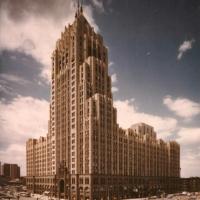 The Fisher Building (1989). (Picture-Detroit Free Press archives)
The Fisher Building (1989). (Picture-Detroit Free Press archives)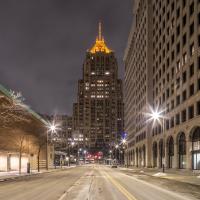 The Fisher Building got the nickname the Golden Tower because it once was covered in gold-leaf faced tile. But there was a fear that the tower would be a target for bombing during World War II, so it was cover with asphalt material. Eventually when the war ended, the asphalt could not be removed without causing damage, so it was replace with green terra cotta tile. And now during the lights are shined onto the tip of the tower to give a gold appearance. (Picture-Helmut Ziewers (www.ziewersphotography.com) of HistoricDetroit.org)
The Fisher Building got the nickname the Golden Tower because it once was covered in gold-leaf faced tile. But there was a fear that the tower would be a target for bombing during World War II, so it was cover with asphalt material. Eventually when the war ended, the asphalt could not be removed without causing damage, so it was replace with green terra cotta tile. And now during the lights are shined onto the tip of the tower to give a gold appearance. (Picture-Helmut Ziewers (www.ziewersphotography.com) of HistoricDetroit.org)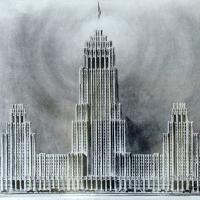 Original planned Fisher Building with the two other towers. (Picture - Albert Kahn Associates Inc.)
Original planned Fisher Building with the two other towers. (Picture - Albert Kahn Associates Inc.)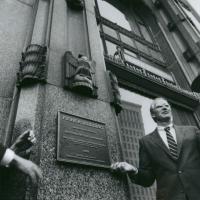 The Fisher Building becomes a National Historic Landmark in 1990. (Picture - Detroit Free Press archives)
The Fisher Building becomes a National Historic Landmark in 1990. (Picture - Detroit Free Press archives)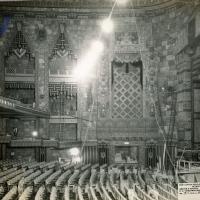 The Fisher Theatre was design with a Mayan theme (Picture - The Platform)
The Fisher Theatre was design with a Mayan theme (Picture - The Platform)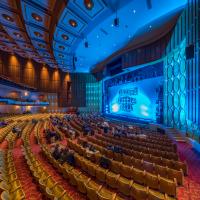 The Fisher Theater renovated (Picture - Helmut Ziewers (www.ziewersphotography.com) of HistoricDetroit.org)
The Fisher Theater renovated (Picture - Helmut Ziewers (www.ziewersphotography.com) of HistoricDetroit.org)




